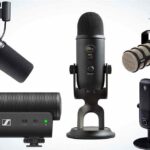To get a microphone to work on a Mac, you will need to plug the microphone into one of the ports located on your computer. You may have either an analog or digital port, depending on the type of microphone you are using. Once connected, open System Preferences and select Sound.
On the Input tab, make sure that your microphone is selected as the input device and adjust its volume level accordingly. Next, open any application that requires audio input such as GarageBand or iMovie and ensure that it is set to use your external mic in its settings menu. Finally test out your configuration by recording some audio with your chosen program and listening back to confirm it is working correctly.
Table of Contents
Mic Not Working? How to Fix Microphone Problems on macOS/MacBook
Getting a microphone to work on your Mac is surprisingly simple. All you need to do is plug the mic into the headphone jack of your computer and then open up System Preferences > Sound, where you can adjust settings for both input and output. From there, simply select the microphone from the Input tab and make sure it’s turned on – that’s all there is to it!
You’ll be ready to start recording or streaming in no time!
How Do I Get a Microphone to Work on a Mac Step by Step Guide!
How To Enable Microphone On Safari Mac
Enabling the microphone in Safari on a Mac involves allowing permissions for websites to access your microphone. Here’s a step-by-step guide:
- Open Safari:
- Launch the Safari browser on your Mac.
- Visit a Website:
- Go to a website that requires microphone access. This could be a video conferencing site, a voice recorder, or any other site that uses the microphone.
- Check for Microphone Icon:
- Look for a microphone icon in the address bar. When Safari detects that a website wants to use your microphone, it will display a small icon that looks like a microphone.
- Click on the Microphone Icon:
- Click on the microphone icon in the address bar. This will open a dropdown menu.
- Select “Allow”:
- From the dropdown menu, select “Allow” to grant permission for the website to access your microphone.
- Reload the Page:
- After granting permission, you may need to reload the page for the changes to take effect. You can do this by clicking the reload button in the address bar or pressing Command (⌘) + R.
- Check System Preferences:
- If you are still having issues, you can check your system preferences to ensure that the microphone is allowed for Safari.
- Go to the Apple menu and select “System Preferences.”
- Click on “Security & Privacy.”
- Navigate to the “Privacy” tab.
- Select “Microphone” from the left sidebar.
- Make sure Safari is checked in the list of apps allowed to access the microphone.
- If you are still having issues, you can check your system preferences to ensure that the microphone is allowed for Safari.
- Restart Safari:
- If you’ve tried the above steps and the microphone still isn’t working, you can try restarting Safari.
- Check Browser Settings:
- Some websites may have their own settings for microphone access. Make sure to check the settings within the website or web application to ensure that the microphone is enabled.
By following these steps, you should be able to enable the microphone in Safari on your Mac for websites that require it. Keep in mind that privacy and security are essential, so only allow microphone access to trusted websites.
How to Enable Microphone on Mac
Enabling the microphone on a Mac involves a few simple steps. Here’s a guide on how to do it:
- Check the Hardware: Ensure that your microphone is properly connected to your Mac. If you’re using an external microphone, make sure it’s plugged into the correct port.
- System Preferences:
- Click on the Apple logo in the top-left corner of your screen.
- Select “System Preferences” from the drop-down menu.
- Sound Preferences:
In the System Preferences window, find and click on the “Sound” icon.
- Input Tab:
Within the Sound preferences, go to the “Input” tab. This is where you can manage your microphone settings.
- Select Microphone:
You should see a list of available input devices. Select your microphone from the list.
- Adjust Input Volume:
Adjust the input volume slider to an appropriate level. You can test your microphone by speaking into it and observing the input level bars.
- Check for Mute:
Make sure that the “Mute” option is not checked if you want to enable the microphone.
- Check Privacy Settings (macOS Catalina and later):
- If you are using macOS Catalina or a later version, check the privacy settings for microphone access.
- Go to “System Preferences” > “Security & Privacy” > “Privacy” tab.
- Select “Microphone” from the left sidebar and ensure that the application you are using the microphone with has the necessary permissions.
- Restart Applications:
If you’ve changed microphone settings while an application is running, you may need to restart the application for the changes to take effect.
By following these steps, you should be able to enable your microphone on your Mac. If you continue to experience issues, you may want to check for software updates, as updates can sometimes resolve compatibility problems.
How to Use Microphone on Mac to Type
To use your microphone on a Mac for speech-to-text input, you can take advantage of the built-in dictation feature. Here’s a step-by-step guide on how to enable and use the microphone for typing on your Mac:
Enable Dictation:
- Click on the Apple logo in the top-left corner of your screen.
- Select “System Preferences.”
Access Keyboard Preferences:
In the System Preferences window, click on “Keyboard.”
Enable Dictation:
- In the Keyboard preferences, click on the “Dictation” tab.
- Toggle the “Dictation” switch to turn it on.
Choose Dictation Mode:
Choose whether you want to use “Enhanced Dictation” (which allows offline use and continuous dictation) or regular dictation (which requires an internet connection and processes your speech in chunks).
Select Language:
Choose your preferred language for dictation.
Activate Dictation Shortcut:
- Click on the “Dictation Commands…” button if you want to customize commands.
- You can also set a keyboard shortcut to activate dictation. By default, it’s usually the “fn” (function) key pressed twice.
Use Dictation:
- Once dictation is enabled, you can activate it by pressing the designated shortcut or using the fn key twice, depending on your settings.
- Start speaking, and your Mac will convert your speech to text.
Remember that dictation requires a reliable internet connection for processing in the regular dictation mode. If you choose enhanced dictation, the language models are downloaded to your Mac, allowing for offline use.
Keep in mind that while dictation can be quite accurate, it may not be perfect, and it might struggle with certain accents or in noisy environments. Adjustments to your speech patterns and pronunciation can improve accuracy over time.
Additionally, third-party applications may offer alternative speech-to-text solutions, so you might explore the Mac App Store for additional options if the built-in dictation does not meet your needs.
How to Allow Microphone Access on Mac Chrome
If you are a Mac user and need to use your microphone with Chrome, it’s very simple. All you have to do is open the Chrome browser, click on the three dots in the top right corner of the window, select Settings from the drop-down menu and then scroll down until you locate Site Settings. Under that heading make sure that Microphone access is enabled.
You will also want to make sure that any site requesting access has been approved by clicking on ‘Allow’ when prompted for permission. Now your microphone should be ready for use!
Microphone on Macbook
The Macbook comes with a built-in microphone that is perfect for recording audio or making video calls. It’s compatible with the latest versions of macOS, so you can easily record your own podcasts and music recordings right from your computer – no external gear required! You can also use it to make conference calls or chat over Skype or FaceTime, allowing you to stay connected while on the go.
The quality of sound produced by the microphone is surprisingly good, especially considering its small size.

Credit: www.youtube.com
How Do I Use an External Microphone on My Mac?
Using an external microphone on your Mac is easy. To start, you’ll need to connect the microphone to your Mac computer via a USB cable or audio line-in port. Once connected, go into System Preferences > Sound and select “Input.”
From there you can choose which input device (your external microphone) you want to use as the main sound input for your system. You may also need to adjust the Input volume slider in this section so that it’s at a comfortable level for recording purposes. That’s all there is to it!
After setting up the external mic, you’ll be able to take advantage of improved audio quality when speaking during video calls or making recordings with applications such as GarageBand and Audacity.
Why Isn’T My Microphone Working on My Mac?
If your microphone isn’t working on your Mac, there are a few things you can do to troubleshoot the issue.
First, make sure that the microphone is properly connected and installed in accordance with any instructions supplied by the manufacturer.
Additionally, check to see if the correct input source has been selected in System Preferences > Sound > Input tab.
If those steps don’t work, try resetting your PRAM or SMC as described on Apple’s support page for microphones not working on Macs.
Finally, if none of these solutions fix the problem then it could be due to a hardware failure – please refer to a qualified technician for further assistance.
How Do I Set Up And Test My Microphone on My Mac?
To set up and test your microphone on Mac, start by connecting the microphone to your Mac’s audio input port. Then open System Preferences from the Apple menu and select Sound. Select Input in the left-hand pane, then choose your connected mic from the list of available devices.
After that, you can adjust any sound settings for this device if needed. To test it out, use an application like Voice Memos or QuickTime Player to record something with your mic and play back the recording to make sure everything works correctly!
How to Turn on Microphone?
To turn on your microphone, you first need to make sure it is properly connected to your computer. If it is a USB microphone, check that the USB cable is securely inserted into both the mic and computer port. Once the connection has been established, open up your audio preferences panel in Windows or Mac OS X and look for an option to ‘enable’ the microphone.
This can usually be found under the Input tab. Make sure that this feature is checked as ‘on’ before attempting any further troubleshooting steps. It may also be necessary for you to adjust additional settings such as volume levels and noise cancellation in order to ensure optimal sound quality from your mic.
Why Can’T My Mac Find My External Microphone?
The most common reason why a Mac cannot find an external microphone is that the mic isn’t plugged in correctly. Make sure you have plugged your external microphone into the correct port on your computer. If it still won’t detect it, try another port or plugging the mic into a different device to make sure it’s working properly.
Additionally, check your sound settings and ensure that your Mac is recognizing the input from the mic by adjusting its volume control and other audio preferences within System Preferences > Sound > Input tab. Lastly, make sure you are using an appropriate cable for connecting to your computer as some cable types may result in compatibility issues with certain devices.
FAQ of How Do I Get a Microphone to Work on a Mac
Q1: How do I connect a microphone to my Mac?
A: Connect your microphone to the Mac using the appropriate cable. For USB microphones, simply plug them into a USB port. For analog microphones, use the headphone jack or a USB audio interface.
Q2: How do I check if my Mac recognizes the microphone?
A: Go to “System Preferences” > “Sound” > “Input.” Your connected microphone should appear in the list. Make sure it’s selected as the preferred input device.
Q3: Why is my microphone not working on my Mac?
A: Check the physical connection, ensure the microphone is powered if required, and verify it’s compatible with your Mac. Go to “System Preferences” > “Sound” > “Input” and select the correct microphone. If issues persist, try restarting your Mac.
Q4: How do I adjust the microphone volume on a Mac?
A: Navigate to “System Preferences” > “Sound” > “Input.” Use the input volume slider to adjust the microphone volume. Additionally, some microphones have their volume controls; check the microphone itself.
Q5: Can I use a Bluetooth microphone with my Mac?
A: Yes, you can. Ensure Bluetooth is enabled on your Mac, and pair the microphone following the manufacturer’s instructions. Then, go to “System Preferences” > “Sound” > “Input” and select the Bluetooth microphone.
Q6: How do I test my microphone on a Mac?
A: Open “System Preferences” > “Sound” > “Input.” Speak into the microphone, and you should see the input level meter respond. Alternatively, use the “Sound” pane in the “Utilities” folder to test your microphone.
Q7: How do I troubleshoot if my microphone is still not working?
A: Try using another microphone to eliminate hardware issues. Check if the microphone works on another device. Restart your Mac, update macOS, and ensure your microphone drivers are up-to-date. If problems persist, contact Apple Support.
Q8: Why is my Mac not detecting my USB microphone?
A: Ensure the USB port is functioning by trying another device. If the issue persists, try a different USB port. Check if your USB microphone requires specific drivers and install them. Restart your Mac and reconnect the microphone.
Q9: How do I record with my microphone on a Mac?
A: Open a recording application like GarageBand or QuickTime Player. Create a new project or recording. In the settings, select your microphone as the input device. Press the record button to start recording.
Q10: Can I use multiple microphones on a Mac?
A: Yes, Macs support multiple microphones. Connect each microphone, go to “System Preferences” > “Sound” > “Input,” and select the desired microphones. Some applications may require additional setup for multiple inputs.
Conclusion
In conclusion, setting up a microphone to work with your Mac is relatively simple. All you need to do is make sure that the microphone is compatible and connected properly, then adjust the settings in System Preferences. If you encounter any issues along the way, there are plenty of online resources available to help troubleshoot and resolve them quickly.
With just a few steps, you can have your microphone set up and ready for use on your Mac in no time!

Williams Kane is a blogger and writer. He’s passionate about writing and connecting with the community, especially when it comes to sharing his ideas through writing.
I am a versatile author with a passion for exploring a wide range of topics on our multi-niche website. With a background in research and a love for writing, I bring a unique blend of expertise to our platform.
My journey began in the world of science, where I earned a degree in biology and developed a deep fascination for the natural world. This background enables me to delve into topics related to ecology, environmental conservation, and the wonders of the animal kingdom.
However, my curiosity knows no bounds, and I have ventured into various other niches as well. From technology trends and digital innovations to health and wellness tips, I strive to provide well-researched and engaging content that informs and entertains our diverse audience.
Furthermore, my dedication to staying current with the latest developments in each niche ensures that our readers receive up-to-date and reliable information. Whether it’s deciphering complex scientific concepts or simplifying tech jargon, I take pride in making complex subjects accessible to all.
Join me on our multi-niche journey, where we explore the depths of knowledge and share insights on a multitude of topics to inspire, educate, and entertain.



